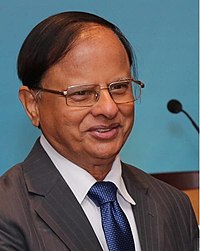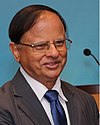| No.
|
Portrait
|
Principal Secretary to the Prime Minister of India |
Took office |
Left office |
Time in office |
Service |
Prime Minister of India
|
| 1 | | Haskar, P. N.P. N. Haksar
(1913–1998) | 6 December 1971 (1971-12-06) | 28 February 1973 (1973-02-28) | 1 year, 84 days | Indian Foreign Service | Gandhi, IndiraIndira Gandhi (INC) |
| 2 | | Shankar, V.V. Shankar | 4 April 1977 (1977-04-04) | 31 July 1979 (1979-07-31) | 2 years, 118 days | Indian Civil Service | Desai, MorarjiMorarji Desai (JP) |
| 3 | | Alexander, P. C.P. C. Alexander
(1921–2011) | 2 May 1981 (1981-05-02) | 18 January 1985 (1985-01-18) | 3 years, 261 days | Indian Administrative Service | Gandhi, IndiraIndira Gandhi (INC)
(2 May 1981 (1981-05-02) – 31 October 1984 (1984-10-31))
Rajiv Gandhi (INC)
(31 October 1984 (1984-10-31) – 18 January 1985 (1985-01-18)) |
| 4 | | Deshmukh, B. G.B. G. Deshmukh
(1929–2011) | 27 March 1989 (1989-03-27) | 11 December 1990 (1990-12-11) | 1 year, 259 days | Indian Administrative Service | Gandhi, RajivRajiv Gandhi (INC)
(27 March 1989 (1989-03-27) – 2 December 1989 (1989-12-02))
V. P. Singh (JD)
(2 December 1989 (1989-12-02) – 10 November 1990 (1990-11-10))
Chandra Shekhar (SJP(R))
(10 November 1990 (1990-11-10) – 11 December 1990 (1990-12-11)) |
| 5 | | Mishra, S. K.S. K. Misra
(born 1932) | 11 December 1990 (1990-12-11) | 24 June 1991 (1991-06-24) | 195 days | Indian Administrative Service | Shekhar, ChandraChandra Shekhar (SJP(R)) |
| 6 | | Verma, A. N.Amar Nath Verma | 25 June 1991 (1991-06-25) | 15 May 1996 (1996-05-15) | 4 years, 324 days | Indian Administrative Service | Rao, NarasimhaNarasimha Rao (INC) |
| 7 | | Satishchandran, T. R.T. R. Satishchandran
(1929–2009) | 12 June 1996 (1996-06-12) | 30 June 1997 (1997-06-30) | 1 year, 18 days | Indian Administrative Service | Deve Gowda, H. D.H. D. Deve Gowda (JD)
(12 June 1996 (1996-06-12) – 21 April 1997 (1997-04-21))
Inder Kumar Gujral (JD) |
| 8 | | Vohra, N. N.Narinder Nath Vohra
(born 1936) | 1 July 1997 (1997-07-01) | 19 March 1998 (1998-03-19) | 261 days | Indian Administrative Service | Gujral, I. K.Inder Kumar Gujral (JD) |
| 9 | | Mishra, BrajeshBrajesh Mishra[a]
(1928–2012) | 19 March 1998 (1998-03-19) | 22 May 2004 (2004-05-22) | 6 years, 64 days | Indian Foreign Service | Vajpayee, Atal BihariAtal Bihari Vajpayee (BJP) |
| 10 | | Nair, T. K. A.T. K. A. Nair
(born 1939) | 28 May 2004 (2004-05-28) | 3 October 2011 (2011-10-03) | 7 years, 128 days | Indian Administrative Service | Singh, ManmohanManmohan Singh (INC) |
| 11 | | Chatterjee, PullokPulok Chatterji
(born 1952) | 3 October 2011 (2011-10-03) | 26 May 2014 (2014-05-26) | 2 years, 235 days | Indian Administrative Service | Singh, ManmohanManmohan Singh (INC) |
| 12 | | Misra, NripendraNripendra Misra
(born 1945) | 28 May 2014 (2014-05-28) | 10 September 2019 (2019-09-10) | 5 years, 105 days | Indian Administrative Service | Modi, NarendraNarendra Modi (BJP) |
| 13 | | Mishra, PramodPramod Kumar Mishra
(born 1948) | 11 September 2019 (2019-09-11) | Incumbent | 4 years, 302 days | Indian Administrative Service | Modi, NarendraNarendra Modi (BJP) |





![Brajesh Mishra[a]](https://upload.wikimedia.org/wikipedia/commons/thumb/e/e6/Brajesh_Mishra.jpg/100px-Brajesh_Mishra.jpg)

